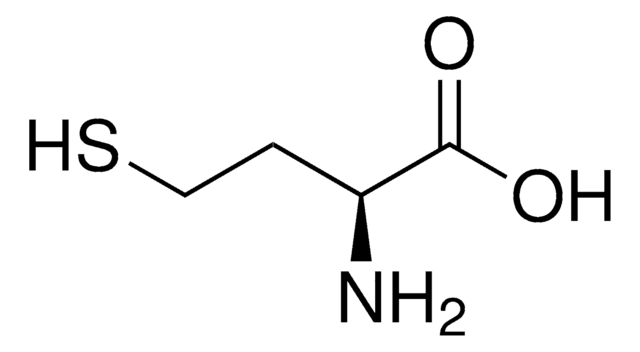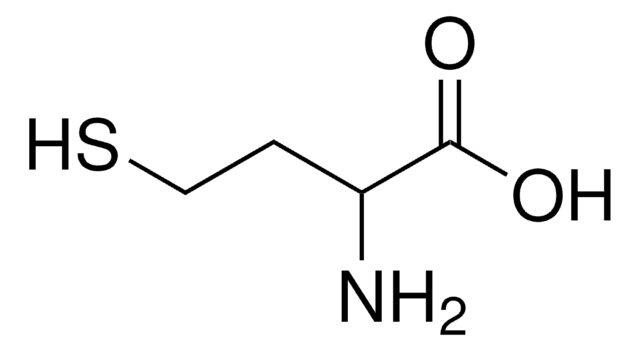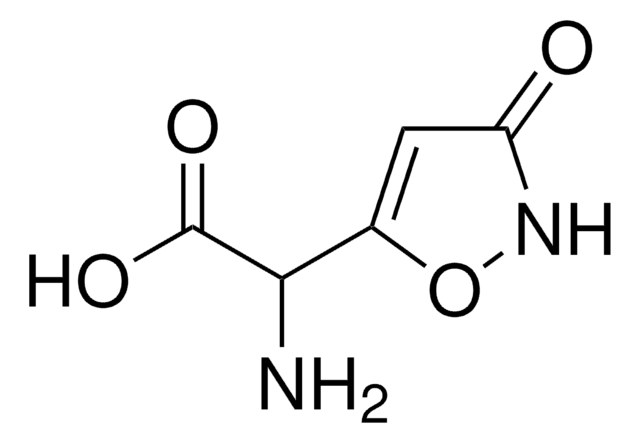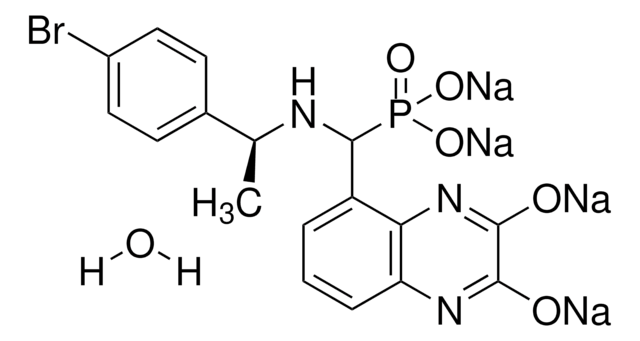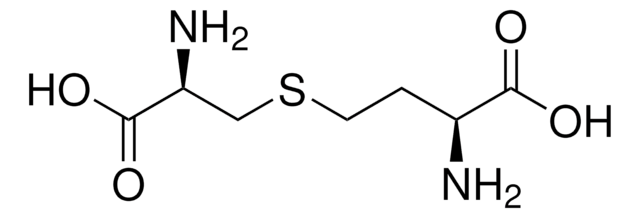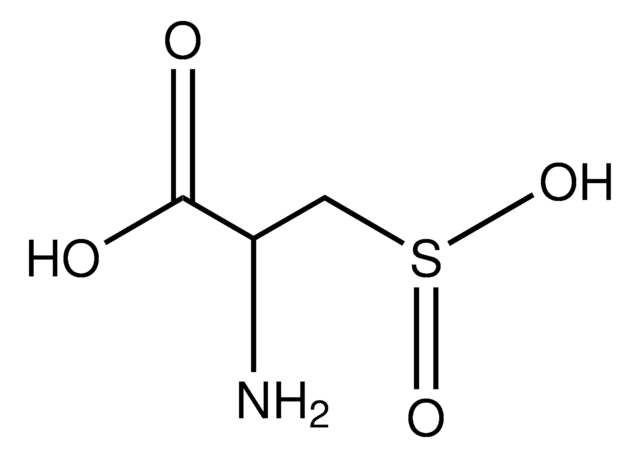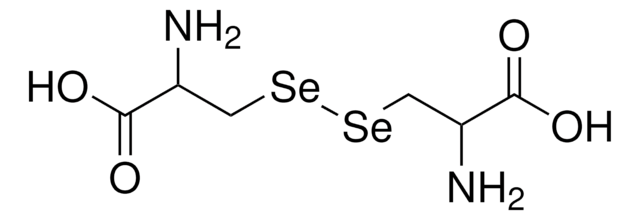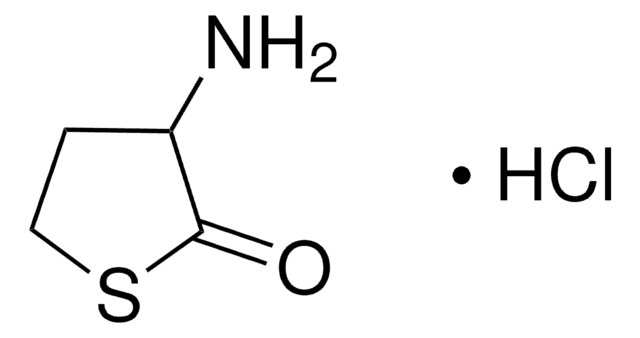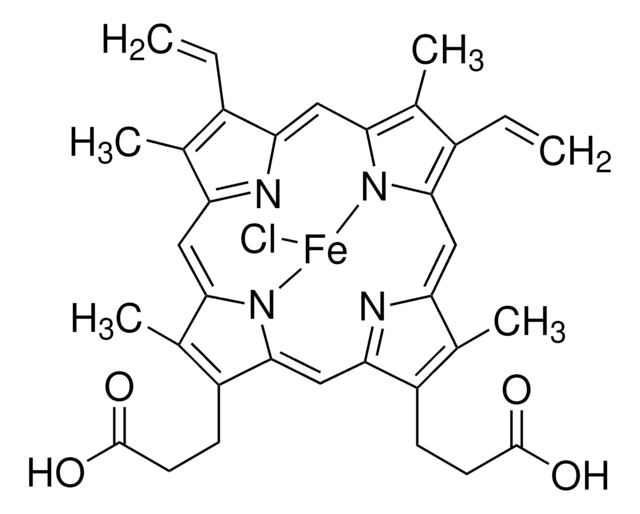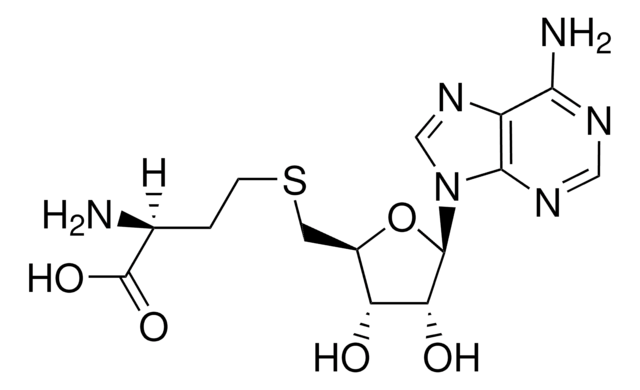H9633
L-Homocysteic acid
≥98% (TLC)
Synonyme(s) :
L-2-Amino-4-sulfobutyric acid
Se connecterpour consulter vos tarifs contractuels et ceux de votre entreprise/organisme
About This Item
Formule empirique (notation de Hill) :
C4H9NO5S
Numéro CAS:
Poids moléculaire :
183.18
Numéro MDL:
Code UNSPSC :
12352106
ID de substance PubChem :
Nomenclature NACRES :
NA.32
Produits recommandés
Nom du produit
L-Homocysteic acid, ≥95%
Niveau de qualité
Essai
≥95%
≥98% (TLC)
Forme
powder
Couleur
white to off-white
Application(s)
cell analysis
Chaîne SMILES
N[C@@H](CCS(O)(=O)=O)C(O)=O
InChI
1S/C4H9NO5S/c5-3(4(6)7)1-2-11(8,9)10/h3H,1-2,5H2,(H,6,7)(H,8,9,10)/t3-/m0/s1
Clé InChI
VBOQYPQEPHKASR-VKHMYHEASA-N
Application
L-Homocysteic acid has been used to study hydrogen peroxide-mediated changes in physiological and pathological conditions in the nervous system.
Actions biochimiques/physiologiques
L-Homocysteic acid (L-HCA) is an endogenous neurotransmitter ligand of NMDA (N-methyl-D-aspartate) receptors. It is an analog of glutamate and competitively suppresses glutamate-cystine (xc-) antiporter function in neurons, causing decrease in cysteine uptake.
Code de la classe de stockage
11 - Combustible Solids
Classe de danger pour l'eau (WGK)
WGK 3
Point d'éclair (°F)
Not applicable
Point d'éclair (°C)
Not applicable
Équipement de protection individuelle
Eyeshields, Gloves, type N95 (US)
Faites votre choix parmi les versions les plus récentes :
Déjà en possession de ce produit ?
Retrouvez la documentation relative aux produits que vous avez récemment achetés dans la Bibliothèque de documents.
Les clients ont également consulté
M Piraud et al.
Rapid communications in mass spectrometry : RCM, 19(22), 3287-3297 (2005-10-20)
Seventy-six compounds of biological interest for the diagnosis of inherited disorders of amino acids (AA) metabolism have previously been demonstrated to be detectable in positive mode electrospray ionisation tandem mass spectrometry (ESI-MS/MS), after separation by ion-pairing reversed-phase liquid chromatography (RPLC).
Hari H Subramanian et al.
The Journal of comparative neurology, 526(2), 229-242 (2017-09-07)
The nucleus retroambiguus (NRA) is a neuronal cell group in the medullary ventrolateral tegmentum, rostrocaudally between the obex and the first cervical spinal segment. NRA neurons are premotor interneurons with direct projections to the motoneurons of soft palate, pharynx, and
Itopa E Ajayi et al.
Respiratory physiology & neurobiology, 252-253, 18-27 (2018-03-20)
Changes in cardiorespiratory control accompany the expression of complex emotions, indicative of limbic brain inputs onto bulbar autonomic pathways. Previous studies have focussed on the role of the prefrontal cortex in autonomic regulation. However, the role of the hippocampus, also
J W Olney et al.
Brain research bulletin, 19(5), 597-602 (1987-11-01)
L-Homocysteic acid (L-HCA) has been proposed as a natural transmitter at the N-methyl-D-aspartate (NMDA) subtype of excitatory amino acid receptor based on recent evidence that L-HCA occurs L-HCA occurs naturally in the mammalian CNS, is released from K+ stimulated brain
T Knöpfel et al.
Neuroscience letters, 81(1-2), 188-192 (1987-10-16)
The effects of ionophoretically applied L-homocysteate (L-HCA), L-glutamate (L-Glu) and N-methyl-D-aspartate (NMDA) were compared in rat neocortical neurons recorded intracellularly in vitro. The firing pattern and the time course of membrane depolarization induced by L-HCA resembled those of NMDA responses.
Notre équipe de scientifiques dispose d'une expérience dans tous les secteurs de la recherche, notamment en sciences de la vie, science des matériaux, synthèse chimique, chromatographie, analyse et dans de nombreux autres domaines..
Contacter notre Service technique